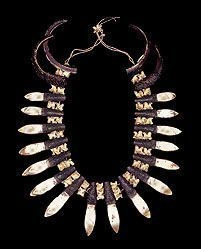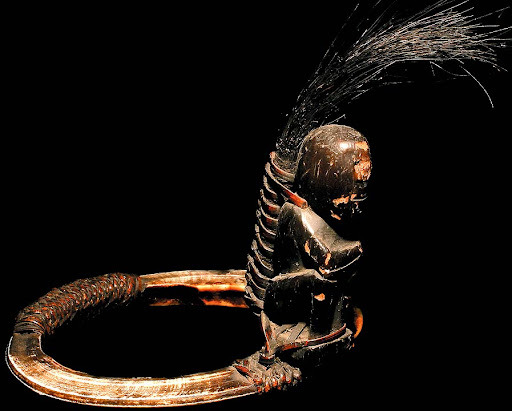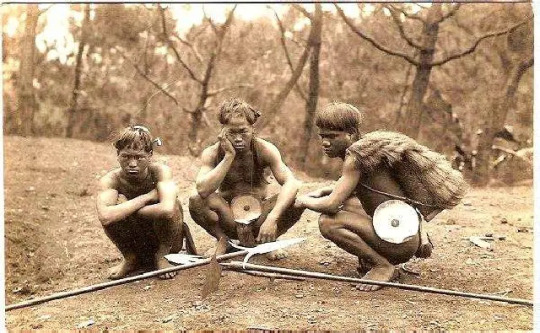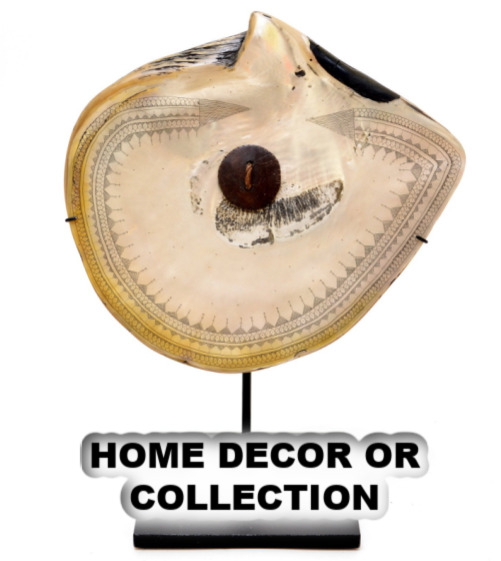Text
BONTOC: A CLOSER LOOK INTO ITS DESIGN MOTIFS, ORNAMENTATIONS, AND ELEMENTS
A) BOAYA NECKLACE
Fig. 1 : BOAYA Necklace [Reference]

ORIGINAL FUNCTION/MEANING OF THE MOTIFS/ORNAMENTS/ELEMENTS
Handmade from wild boar’s tusks and runo reed—this physical adornment is worn by priests and warriors during headhunting rites, ceremonies and dances.
HISTORICAL SIGNIFICANCE
This is worn by men with the tangkil (this collection), as in the begnas rice-growing ceremony. The runo sticks have visible inlaid motifs. Each of the tusks is woven using rattan basketry. This necklace is renamed after the local term for crocodile since older versions were crafted with crocodile teeth. These items are now considered heirlooms.
EXAMPLES WHERE YOU CAN APPLY/USE THESE ELEMENTS TODAY
Today, Boaya is being reproduced in some parts of the world and are being worn during cultural festivals.
B) TANGKIL
Fig. 2 : TANGKIL [Reference]

ORIGINAL FUNCTION/MEANING
A boar's tusk upper arm adornment, bound by rattan weaving and embellished with a wooden "bul ul" figurine with human hair fringes.
HISTORICAL SIGNIFICANCE
During ceremonies and rituals, such as the begnas rice production ritual, men wear a pair of these. Warriors from Northern Luzon tribes like as the Gaddang, Bontoc, and Kalinga wear this armlet to symbolize and be recognized by their "strength and bravery".
EXAMPLES WHERE YOU CAN APPLY/USE THESE ELEMENTS TODAY
Just like the Boaya, Tangkil is also being reproduced in some parts of the world and are being worn during cultural festivals
C) SUKLANG (Bachelor’s hat)
Fig. 3 : SUKLANG [Reference]

ORIGINAL FUNCTION/MEANING
With a pin and an eagle pattern in the center, this physical adornment is a carefully woven headgear made of colored fabrics, boar's tusk, and beads.
HISTORICAL SIGNIFICANCE
It was worn by men and it was primarily used as a storage for personal items such as tobacco. It is worn on the back of the head and secured with the black beads string across forehead.
EXAMPLES WHERE YOU CAN APPLY/USE THESE ELEMENTS TODAY
During festivals and celebratory events, elderly seniors in Bontoc and neighbouring villages still wear the suklang.

D) FIKUM
[Reference]
Fig. 4 : Local Bontoc warriors with Fikum

Fig. 5 : Fikum. Mother of pearl shell, 20 cm in diameters, central medallion of coconut shell, etched edges, tassel of beads. Bondoc, Northern Luzon, Philippines, early 20th century

ORIGINAL FUNCTION/MEANING
The shells of pearl mussels (‘pinctada fucata,' found in warm, tropical portions of the Pacific) are used to make these spherical fikum discs. The mother of pearl discs are punctured twice in the middle and embellished with engraved exquisite geometric designs around their edges after being traded in the highlands from the shore.
The ornamental engraving along the edge of the current fikum disc of a Bontoc warrior is particularly pretty. In the middle is a little perforated mother of pearl disc that serves as a counterpoint to the braided rattan holding strap that was used to secure the fikum to the Bontoc warrior's belt.
HISTORICAL SIGNIFICANCE
The only respected warriors among the Bontoc, a group in Luzon's central, northern region, are supposed to wear these adorned shells, known as 'fikum,' on their left hip as a mark of their prowess - as jewelry and a kind of 'medal of bravery.'
The fikum shows that they are recognized as warrior headhunters of the kadangyan class—the wealthy class within the social structure of the Igorot people.
EXAMPLES WHERE YOU CAN APPLY/USE THESE ELEMENTS TODAY

2 notes
·
View notes